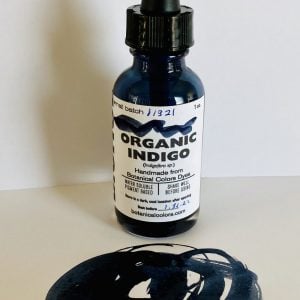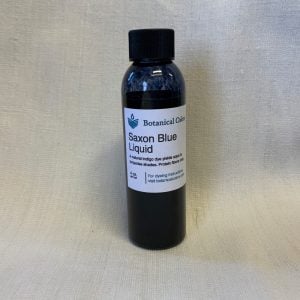Search Results for: indigo round up
FEEDBACK FRIDAY: This Week in Natural Dye Questions
This week: scouring, reducing, hydrating and are fresh flowers better than dry flowers for natural dyeing?
Organic Indigo Ink – 3 Varieties
Organic Indigo Ink We offer 3 indigo ink varieties created by Judi Pettite of Biohue, our ink maker extraordinaire. Each variety has a slightly different blue shade and viscosity and all are beautiful! Judi Pettite started BioHue in 2006 after falling in love with colors she was getting from plants. Since that time, she has foraged, purchased or grown the materials for her art. She makes her inks and watercolors intentionally from the fewest ingredients possible. This minimalist approach also allows the personality of the plant to come through. We love Judi’s work! So we thought taking Botanical Colors’ most … Read more
MORDANT MONDAY: Indigo & Discharging Mordants
We get mordant questions all the time at Botanical Colors so why not create Mordant Monday??? Got mordanting questions? Email [email protected] YOU ASKED: My question involves the processes of indigo dyeing when combined with other plant dyes that have been mordanted with aluminum acetate. My understanding is that citric acid discharges the mordant and also neutralizes the alkalinity of indigo as a last step in finishing indigo dyed cloth. How would you go about neutralizing indigo without discharging mordant? For some processes, I am wanting to use indigo on top of other colors rather than underneath. Can vinegar be used … Read more
Sea Island Indigo Retreat Recap!
We had so much fun at the first Sea Island Indigo retreat in Charleston last week. Check out the post Heather Powers wrote up on the event as well as some wonderful images she took of our weekend picking, dyeing and eating well on the farm. More here… Image of Kathy Hattori by Heather K. Powers
Aquarelle Liquid Indigo – Saxon Blue
The legendary Aquarelle Liquid Indigo – Saxon Blue is now available to natural dyers. First created in Germany in the 1740s, it is made from natural indigo converted with a strong acid to mimic an acid-type dye. It is not a vat dye and you do not use it like vatted indigo. It is an easy and marvelous color for wool fibers. Saxon blue is greener than traditional vatted indigo. In addition, it is a great base for teal, aqua, cornflower, periwinkle, lilac and medium value purple. To use, simply measure out the amount of liquid indigo and add to … Read more
Make An Easy, Organic Indigo Vat
In 2009 and 2010 I had the opportunity to study with natural dye master Michel Garcia. He is a marvelous and knowledgeable teacher, fascinated with using the chemistry of simple ingredients to create natural colors. One of the things that he demonstrated to us was to be fearless about the indigo fermentation vat. What a gift! For me, the indigo fermentation vat has always been a mystery and I could never quite figure out all the details so I never pursued it. I was getting great and consistent color with my lye and soda ash and chemical reducing agents, so why … Read more
Vibrant Valley Blue Indigo Paste
We are thrilled to introduce a new, Pacific Northwest-based indigo paste from the incredible growers and dyers at Vibrant Valley Farm. Kara Gilbert and her skilled team created Vibrant Valley Blue, a Persicaria tinctoria indigo extract. This product is based on years of growing, harvesting and experimenting with varieties, cultivation and extraction and they’ve scaled their production from a few hundred starts to a robust crop of over 10,000 plants. The resulting indigo paste is easy to use and creates a beautiful clear blue. Kara used this indigo to dye a number of garments and styles to hold fashion shows … Read more
You Asked, Kathy Answered: The pH of Indigo
We get lots of emails from customers about challenges with dyeing and needing Botanical Colors’ President Kathy Hattori’s help. Why not share the learning so we can all benefit? From our inboxes to you, it’s simple: You Asked, Kathy Answered. Email questions@botanicalcolors with your plea for help! YOU ASKED: I set up an indigo vat a few weeks ago using fructose and lime. I dyed a few cotton items which worked well and now I want to dye some wool and silk. I’m having trouble lowering the pH. I’ve added more fructose but the pH is still 10.9. I tried … Read more
MORDANT MONDAY: Will Mordant Affect Indigo Dyeing?
We get mordant questions all the time at Botanical Colors so why not create Mordant Monday??? Got mordanting questions? Email [email protected] YOU ASKED: I use aluminum triformate as my mordant for cellulose and silk. I am planning to dye linen with weld and was told that I didn’t need to use a tannin before dyeing if using potassium triformate.If I do need to use a tannin and have already mordanted the linen, do I go back and use tannin and remordant? KATHY ANSWERED: I have concentrated on using a tannin pretreat with aluminum sulfate and haven’t done so as frequently … Read more










